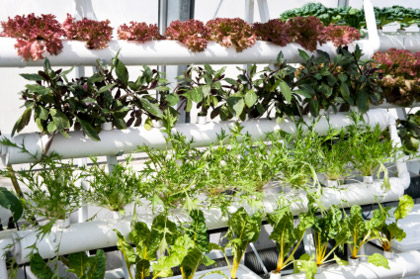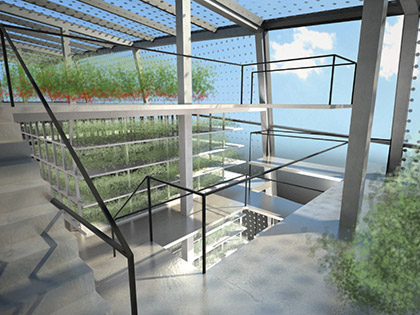Vertical Harvest of Jackson Hole A Replicable Program for Food Security
Most experts agree that traditional farming will not be able to keep pace with the expanding human population. According to the United Nations, the world’s population is predicted to increase to 9.1 billion by 2050, an addition of 3 billion throughout the next 40 years1. Feeding those extra mouths will require a 70 percent increase in food production2. However, 80 percent of the world’s arable land is already in use3. Unsettled by the expanding population, dwindling farmland and environmental impact of agricultural production, Dickson Despommier was the first person to envision vertical farms as an ecological solution to this problem. He wanted to vastly reduce the amount of land and resources needed to grow fresh, healthy produce while increasing nutritional value and accessibility. Farming vertically, he proposed, would not only accommodate those extra mouths, it would also reduce mankind’s carbon footprint.4
A vertical farm can take many forms, but, conceptually, it is a multi-story greenhouse, which uses modern technologies, such as hydroponics or aeroponics, that require no soil to grow produce. In aeroponic practice, stacked and suspended plants are sprayed with a fine mist enriched with the necessary nutrients for growth. In hydroponic practice, plants are installed in vertical rows, suspended by a medium, such as gravel, wool or volcanic glass. The roots are immersed in nutrient rich water, and constant airflow allows the plants to receive the necessary carbon dioxide for growth. Per acreage, farmers currently using hydroponic techniques have crop yields of up to 30 times those of traditional farmers. When vertical farming takes advantage of the same technology, using the structure’s height to maximize the acreage’s growing capacity, it is predicted to increase many times over5.
Advantages of vertical farming are abundant. If the practice becomes widespread, traditional farmland may be restored to its natural ecological function, and herbicides, pesticides and fertilizers will be largely eliminated. Tractors and plows, which burn fossil fuels, will no longer be needed. Crops within greenhouses do not face the risk of weather-related failure, use far less water and can be grown in close quarters with the community it supplies. This significantly reduces both transportation costs and fossil fuels associated with shipping produce, as well as spoilage along the way. Despommier’s list of benefits has global consequences, such as reduction of conflict over land and water for agriculture. He also sees vertical farms as a potential solution to food deprivation in refugee camps because they can be set up in any environment, and they are a preventive measure for diseases acquired at agricultural interfaces6. Pools of stagnant water that exist on many traditional farms, for example, are prime breeding grounds for mosquitoes – the world’s deadliest insect because of the diseases it spreads7.
Vertical Harvest of Jackson Hole (VHJH) is a project focused on building a three-story hydroponic greenhouse in the heart of a Wyoming town. It has taken the virtues of vertical farming and expanded on them to include real community benefits for Jackson, Wyo., with the hope that other communities will follow in its footsteps.

iStockphoto.com/yuyanga|Hydroponic Greenhouse
Two years ago, Jackson Hole resident and sustainability consultant, Penny McBride, was working on a food waste diversion feasibility project when a friend inquired about employment opportunities for people with disabilities. Realizing that opportunities for this population were woefully inadequate, McBride decided to pursue her vision of creating a greenhouse that could be accessible via public transportation. She found a unique concept in Nona Yehia, the architect behind the project, who proposed building a vertical farm specifically designed to allow access and employment for people with disabilities. Partnering with experienced greenhouse engineer, Thomas Larssen, they combined an architectural and social vision to found Vertical Harvest.
Nationally, the unemployment rate for people with disabilities is 72 percent, but in Wyoming it is even higher at 78 percent8. Most of the work that citizens with disabilities do have is menial, thus providing little increase in their quality of life and/or social interaction. Vertical Harvest wants to create meaningful employment for these citizens – something that integrates them into the Jackson Hole community and teaches them a skill in which they can take pride.
“We have a very high unemployment rate for people with disabilities. And, lack of creative job positions leaves them feeling hopeless regarding a successful future with a career that interests them,” says VHJH Advisory Board Member Caroline Croft-Estay, who is also an independent case manager for people with disabilities. “Employment assists in increasing independence in their communities. It gives them financial gain, an opportunity to be involved with others in the work place and a means to be part of something as a whole. In turn, self confidence is gained, relationships are formed and a positive outlook on life is manifested not only for the citizens with disabilities but also for those who live and work around them as well,” explains Croft-Estay.
Hoping to be a good model for other businesses, the project’s goal is also to demonstrate how both children and adults with disabilities can have a positive impact on a work environment. According to a disability employment report by Rutgers University, people with disabilities are more job-loyal, on-time and likely to stay at a job for a longer duration than people without disabilities. As report author Suzanne Robitaille points out in her assessment of these findings, those qualities directly correlate to company productivity and, in turn, profitability9.
Vertical Harvest of Jackson Hole is three-pronged: Grow fresh, local produce year-round; provide meaningful employment for people with disabilities and create a sustainable model that can be replicated elsewhere. While Vertical Harvest’s main goal is not profitability, as an L3C it must maintain a profitable business in order to survive. As its website www.verticalharvest.org states, an L3C is a for-profit with a non-profit soul – a new kind of limited liability company pioneered by companies like Patagonia that enables a business with a primarily charitable function to be self-sustaining. The hope is that once the flagship project takes off, the proceeds and profit can be used to start another project in communities with similar needs.
“This project is unique as it addresses a need in a smaller community for very high quality local produce and creates new, good jobs, all combined with using an almost impossible building lot up against a parking garage. The most unique [aspect] of the project might be the fact that this vertical greenhouse will show a viable business case,” comments greenhouse engineer Thomas Larssen.

© E/ye Design
Even though the project began with the central goal of providing inclusive employment for people with disabilities, it has gained popularity in the Jackson Hole community for another ambition. Growing fresh local produce all year long in a climate that suffers through sub-zero temperatures during the winter months is cause for celebration. A limited number of restaurants in the area will be able to buy a share of this produce, and they are excited to provide their customers with food straight off the vine every day of the year. A retail store on-site will allow the entire community access to the produce, and local grocery stores will also carry a limited amount of produce. People are rallying around the idea – that in the heart of winter, they will be able to walk on-site and purchase a freshly grown local tomato.
The plot of land on which Vertical Harvest will be built sits in the heart of downtown Jackson near a bus stop for easy access. It is an unused plot owned by the town adjacent to a parking structure with a façade that is less than appealing. Only 30 ft. x 150 ft., it is not much to look at, but it will provide 12,995 sq. ft. of growing space for tomatoes, strawberries, herbs, lettuce, micro-greens and a rotation of other crops.
The placement of the crops within the structure was a carefully researched and strategically planned process. All plants within the greenhouse will be grown using hydroponics with a combination of natural light, LED lighting and traditional metal halide lighting. The third floor of the greenhouse is the most conventional, as it will maximize the sun’s energy using exposure from both the southern aspect of the building and the glass roof. Metal halide lighting will supplement the natural lighting to ensure crops of tomatoes can be harvested all year long. The second floor will house the lettuce and herbs, which will be grown with LED lighting. The bottom floor will house both the on-site retail store and an educational center, but plants will also cover the façade so that no natural light goes to waste. Perhaps the most dynamic architectural element, however, is a living carousel wall that spans the first 2 floors of the building and maximizes the natural light. The wall’s design rotates the crops continuously and enables people with limited mobility to easily access and harvest the plants.
This project centers on community by providing healthy eating options and an inclusive atmosphere, but it also plans on educating visitors and future generations on sustainability. As mentioned above, the bottom floor of the building includes an educational center. With a goal of replication in mind, Vertical Harvest wants to share its knowledge of hydroponics, vertical farming and renewable energy systems with anyone who wishes to learn. The project will provide hands-on learning opportunities to school children throughout the state on core science topics, such as environmental sustainability and food nutrition. Older students will receive a more detailed education on how ecological sustainability is an important driving force behind an innovative design approach. The hope is that through the sharing of information, visitors and children will be armed with knowledge that will help carry Vertical Harvest’s mission into the future and other communities.
When all these factors are added up, VHJH is a pioneer in its field. Distinguishing itself from other vertical greenhouse projects and hydroponic operations, it takes a multi-purpose approach to food growth and a sustainable lifestyle. “It combines a powerful trio of things I consider to be game-changers in life. These include prioritizing and equalizing the playing field for people with developmental disabilities, year round quality food production that could be replicable and a commitment to environmental design, which could break through existing barriers regarding greenhouses and energy use,” says Advisory Board Member Anna Olsen and mother of a child with disabilities.
The combination of food production in a frontier state that has a normal growing season of three months with an employment model that prioritizes a marginalized group of individuals and a building that is both architecturally and agriculturally innovative is a monumental achievement. The provision of educational tools is socially responsible and ties all the components together into something the community can understand and take away. The hope is to spread the word about the project so that down the road it is seen as a cause worthy of continuous replication.

© E/ye Design




























